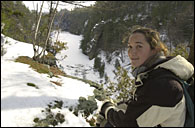Saving salamanders
The Brace Centre for Water Resources Management has made a name for itself in such realms as irrigation and water table management. It's not a centre one associates with the protection of endangered species. All of which makes a recent grant of $30,000 from the Nature Conservancy of Canada to help ensure the survival of the mountain dusky salamander somewhat unusual.
 Graduate student Daphne Wellman
Graduate student Daphne WellmanPHOTO: Normand Blouin |
|
This eight-centimetre long, burgundy salamander is classified as endangered, meaning that it faces imminent extinction if its habitat is changed. The north face of Covey Hill, in southwestern Quebec near the towns of Hemmingford, Havelock and Franklin, is the only place in Canada where the mountain dusky is found. Here, a few trickles of groundwater, seeping into tiny streams, meet this amphibian's very particular habitat needs.
Because groundwater is formed when precipitation works its way through the earth to a permeable water-bearing layer, such as sandstone or fractured rock, it provides a relatively stable source of water and, most importantly, one that doesn't freeze or evaporate. Little, however, is known about the entire aquifer, or groundwater system, in the Covey Hill area 50 km south of Montreal.
Herein lies the connection to McGill's Brace Centre. "We will be looking at the ground water contribution to the stream flow," says the coordinator of the Adirondack Aquifer Project, civil engineer Catherine Senecal. Senecal has recently put together the project's advisory board that includes Peter Brown, of the McGill School of the Environment; professor of law Madeleine Cantin Cumyn; scientists from the Plattsburgh State University of New York; Marie Laroque, a hydrogeologist from the Université du Québec à Montréal; Joël Bonin, a salamander specialist at the Nature Conservancy of Canada; and Chandra Madramootoo, director of the Brace Centre.
Science graduate student Daphne Wellman is beginning the groundwork by studying and mapping the flow dynamics and contribution of groundwater to the surface flow in the natural spring habitats of Covey Hill, the only Adirondack mountain on this side of the border. She's currently gathering existing data on the 200 square kilometre area. Plugging in such data as the soil profiles of local wells, the topography, rainfall and the results of existing stream-flow studies into a GIS (geographical information systems)-type computer program, Wellman will later "ground-truth" that data.
"If all goes well, I should be able to locate springs, know the percentage of streams fed by surface water and/or groundwater and, in the latter case, know the nature and extent of the groundwater contribution to stream flow," says Wellman. "In other words, I will be identifying for the Nature Conservancy the main source of the water feeding the streams that form the habitat of the salamander."
Should, for instance, Wellman find that the peat bog is an important "recharge" spot (where significant amounts of water are absorbed by the bog and work their way down the aquifer), the Nature Conservancy would consider buying that area. The conservancy operates by purchasing land on which species of flora or fauna need to be protected.
Aside from being a major aquifer system, the Covey Hill area is well known for its unusual ecosystems and geology and is a transition area between the two ecological regions of the Northern Appalachian Mountains and the St. Lawrence Lowlands. Walking through the area, one finds peat bog, complete with blueberry plants and a few struggling black spruce trees, typical of the sparsely treed taiga ecosystem, found in northern Quebec. One sees outcroppings of "Adirondack rockribs," the Potsdam sandstone bedrock, laid down half a billion years ago, and "the gulf," a dramatic canyon cut by the massive post-glacier flooding, roughly 12,000 years ago.
Accompanying a tour of visitors and researchers on the land late last December, Senecal made the point that the salamanders are indicators of environmental health, like the proverbial "canaries in the coalmine." If their numbers dwindle, it means that the water they depend on is diminished in quantity or quality and other species of flora and fauna will likewise be affected.
And just what might cause a change in groundwater levels? The pumping of water. In rural areas, citizens depend on wells from which groundwater is pumped. Given the relatively sparse population of Covey Hill, this poses little threat to the abundant groundwater. There is interest, however, in pumping groundwater to be bottled commercially.
Irrigation-requiring agriculture, such as large-scale livestock outfits and the intensive cultivation of fruits and vegetables, may also put stress on the aquifer. In the recent report on water policy, the provincial government accepted the conclusion of Cantin Cumyn's paper that groundwater, like surface water, is a common good. "Until now, its status was uncertain," says Cantin Cumyn, who is working with the Nature Conservancy on the legal aspects of protecting the aquifer and the salamander.
"I defend the position that groundwater has the same status as surface water. After all, it's the same water."
When an element, such as water or air, is considered common, it may not be commercialized and is free for the use of all, including those using water for agricultural purposes. Cantin Cumyn acknowledges, however, that the changing nature of agricultural practices may mean that groundwater use may need to be controlled. Traditional apple orchards, for instance, require no irrigation; the densely planted, low-growing, small trees do.
What the research results of the Adirondack Aquifer Project will do is to establish scientifically just what the interactions are between land and water and just what the aquifer's capacity is to recharge. "This understanding will permit the Nature Conservancy to develop conservation and legislative strategies to protect the water from potentially harmful exploitation and, therefore, protect the habitat of the salamander," notes Senecal.

